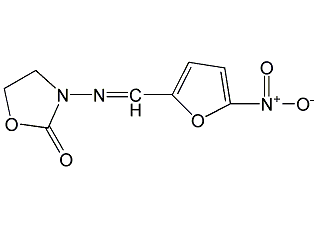
Structural formula
| Business number | 01EN |
|---|---|
| Molecular formula | C8H7N3O5 |
| Molecular weight | 225.16 |
| label |
Furazole, 3-(5-Nitrofurylideneamino)-2-oxazolidinone, 3-(5-Nitrofurfurylideneamino)-2-oxazolidinone, health repellent |
Numbering system
CAS number:67-45-8
MDL number:MFCD00010550
EINECS number:200-653-3
RTECS number:RQ3675000
BRN number:8317414
PubChem number:24894997
Physical property data
1. Properties: light yellow crystalline powder, odorless, bitter
2. Density (g/mL, 25/4℃): Uncertain
3. Relative Vapor density (g/mL, air=1): Uncertain
4. Melting point (ºC): 254-256°C (dec.)
5. Boiling point (ºC, Normal pressure): Uncertain
6. Boiling point (ºC, 5.2kPa): Uncertain
7. Refractive index: Uncertain
8. Flash point (ºC): Uncertain
9. Specific optical rotation (º): Uncertain
10. Autoignition point or ignition temperature (ºC): Uncertain
11. Vapor pressure (kPa, 25ºC): Uncertain
12. Saturated vapor pressure (kPa, 60ºC): Uncertain
13. Heat of combustion (KJ/mol) : Uncertain
14. Critical temperature (ºC): Uncertain
15. Critical pressure (KPa): Uncertain
16. Oil and water (octanol /water) distribution coefficient: Uncertain
17. Explosion upper limit (%, V/V): Uncertain
18. Explosion lower limit (%, V/V) : Uncertain
19. Solubility: Insoluble in water, ethanol, slightly soluble in chloroform, soluble in 40mg of this product in 1L water, slightly soluble in dimethylformamide
Toxicological data
None yet
Ecological data
None yet
Molecular structure data
1. Molar refractive index: 50.96
2. Molar volume (cm3/mol): 135.5
3. Isotonic specific volume (90.2K ): 396.9
4. Surface tension (dyne/cm): 73.5
5. Polarizability (10-24cm3): 20.06
Compute chemical data
1. Reference value for hydrophobic parameter calculation (XlogP): None
2. Number of hydrogen bond donors: 0
3. Number of hydrogen bond acceptors: 6
4. Number of rotatable chemical bonds: 2
5. Number of tautomers: none
6. Topological molecule polar surface area 101
p>
7. Number of heavy atoms: 16
8. Surface charge: 0
9. Complexity: 326
10. Number of isotope atoms :0
11. Determine the number of atomic stereocenters: 0
12. Uncertain number of atomic stereocenters: 0
13. Determine the chemical bond configuration Number of centers: 1
14. Number of uncertain chemical bond stereocenters: 0
15. Number of covalent bond units: 1
Properties and stability
None yet
Storage method
This product should be sealed and stored in a cool, dark place.
Synthesis method
1. Use ethanolamine as raw material, condense it with urea to obtain β-hydroxyethyl urea, and use nitrosation and cyclization to obtain 3-nitroso-2-oxazolidinone. It is further reduced with iron powder, and then condensed with 5-nitro-2-furfuryldiol diacetate and formaldehyde to obtain furazolidone.
2.Condensation of ethanolamine and urea, nitrosation and cyclization with sodium nitrite, and finally reduction with iron powder and 5-nitro-2-furfur Diol diacetate and formaldehyde are condensed to obtain furazolidone.
Purpose
1. This product is a fungicide with a broad antibacterial spectrum. As an anti-infective drug, it is effective against a variety of Gram-positive and -negative Escherichia coli, Bacillus anthracis, Bacillus paratyphoid, etc. It is used to treat bacterial dysentery, enteritis, and vaginal infections. In recent years, it has been used to treat typhoid fever. better. As an animal medicine and beverage additive, it has special antibacterial effects on Salmonella, such as Pullorum pullorum and Escherichia coli, and also has certain effects on protozoa (coccidia, etc.), and is not prone to drug resistance. Furazolidone is used in small quantities as a fungicide in other applications such as water-soluble coatings and paper pulp.
2.Nitrofuran antibacterial drugs. The antibacterial spectrum is similar to that of furantidine. Its mechanism of action is to interfere with bacterial oxidoreductase, thereby blocking the normal metabolism of bacteria. It has antibacterial effects on Salmonella, Shigella, Escherichia coli, Proteus, Streptococcus and Staphylococcus. Bacteria are not likely to develop resistance to this product, and there is no cross-resistance with sulfonamides and antibiotics. Mainly used for bacillary dysentery, enteritis, typhoid fever, paratyphoid fever and external treatment of vaginaltrichominosis.


